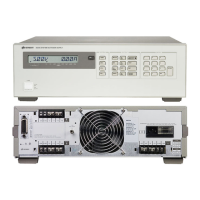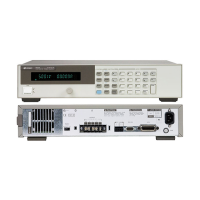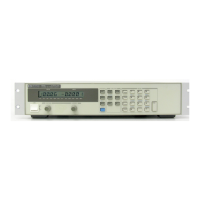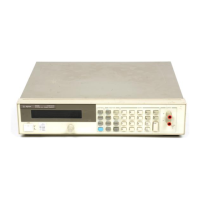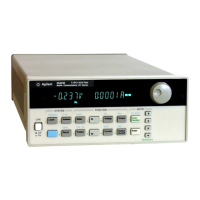e. Program the current of the selected output to the
High Range Full Scale Current value and the
output voltage to 50.5 volts by sending the
following strings:
ISET <ch>, <0.5(25W) or 2(50W)>
VSET <ch>, <50.5>
f. Repeat the load for High Range Full Scale current
and 50 volts indicated on the front panel display.
Check that the CC annunciator is on. If it is not,
adjust the load so that the output voltage drops
slightly.
g. Record the output current reading (DVM reading ÷
10).
h. Adjust the transformer to 6% above the nominal
line voltage.
i. Record the output current reading again. The
difference in the current readings in steps g and I is
the CC source effect and should not exceed the
values listed below for the particular output being
tested.
j. Repeat this test (steps a through I) for each output
in your supply.
3-25 CC RMS Noise. This test measures the rms noise in the
output when operating in the constant current mode.
a. Turn off the supply and connect the output to be
tested as shown in Figure 3-3 with an rms voltmeter
connected across the output, the load switch closed,
and the short switch opened.
b. Turn on the supply and select the output to be
tested (OUTPUT SELECT switch on front panel).
c. Program the current of the selected output to the
High Range Full Scale Current value and the
output voltage to 50.5 volts by sending the
following strings:
ISET <ch>, 0.5
VSET <ch>, 16
NOTE
This test must be performed with a resistive load only. The use
of an electronic load will invariably inject extra ripple and may
cause the CC RMS noise to be out of specification.
d. Adjust the load resistor to about 30 ohms so that
the output voltage is close to 15 volts. Check that
the CC annunciator is on.
e. Note that the reading on the rms voltmeter should
be less than 5 mV (equivalent to 0.1 mA RMS).
f. Repeat this test (steps a through e) for each output
in your supply.
3-26 Performance Test Record
All of the performance test specifications for the power
supply are listed in Tables 3-3 and/or 3-4. Table 3-3 covers
the 25 watt outputs; Table 3-4 covers the 50 watt outputs.
3-27 EXTENDED TESTS
These tests are similar to the Performance Tests except they
have a much longer duration, are conducted with controlled
temperature conditions or test supplemental characteristics.
3-28 Output Drift
The tests are divided into two parts: short term and long
term drift. For all drift tests, place the supply to be tested in
a temperature chamber or in a temperature controlled
environment such as a standards room.
3-29 Short Term Voltage Drift Test. This test measures the
change in output voltage within the first 30 minutes of a
change in the line voltage or the load.
a. Turn off the supply and connect the output to be
tested as shown in Figure 3-3 with the load switch
closed and the short switch opened. Connect the
supply to the ac power line through a variable
voltage transformer and adjust it for the nominal
value.
b. Turn on the supply and select the output to be
tested (OUTPUT SELECT key on front panel).
c. Program the selected output to 50 volts and 0.515
Amps(25W) or 1.03 Amps(50W)
d. Adjust the load for 0.5 Amps(25W) or 1 Amp(50W)
as read on the display. Check that the CV
annunciator is on.
e. Adjust the transformer to 13% below the nominal
line voltage.
f. Wait 30 minutes and record the output voltage
value again. The difference in the readings taken in
steps I and j should be less than 2 millivolts.
g. Adjust the transformer to 6% above the nominal
line voltage.
h. Wait 30 minutes and record the output voltage
value again. The difference in the readings taken in
steps f and h should be less than 2 millivolts.
i. Open the load switch and immediately record the
output voltage reading.
j. Wait 30 minutes and again record the output
voltage reading. The difference in the readings
taken in steps and j should be less than 2 volts.
k. Repeat steps a through j for each output in your
supply.
3-30 Short Term Current Drift Test. This test measures the
change in output current within the first 30 minutes of a
change in the line voltage or the load. Place the supply to be
tested in a temperature chamber or in a temperature
controlled environment such as a standards room.
a. Turn off the supply and connect the output to be
tested as shown in Figure 3-3 with the DVM
connected across the current monitoring resistor,
the load switch closed, and the short switch
opened. Connect the supply to the ac power line
through a variable voltage transformer and adjust it
for the nominal value.
3-10
Artisan Scientific - Quality Instrumentation ... Guaranteed | (888) 88-SOURCE | www.artisan-scientific.com
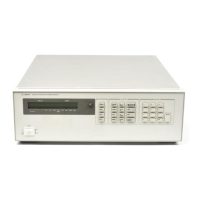
